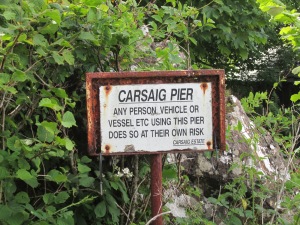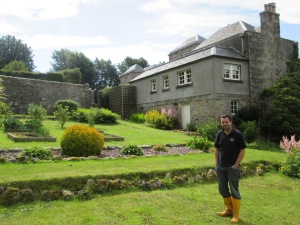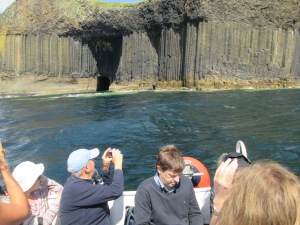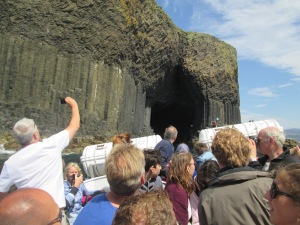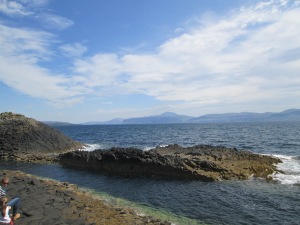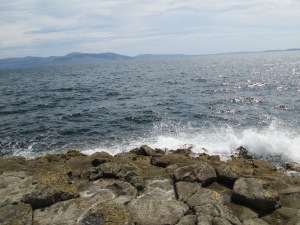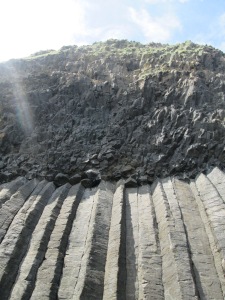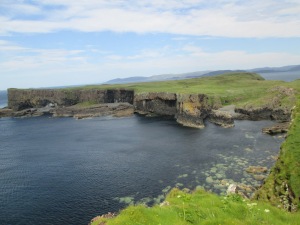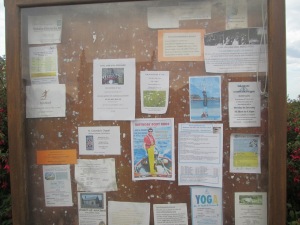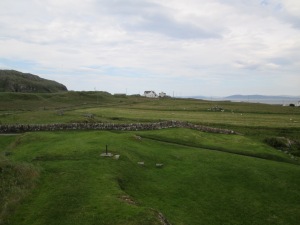‘To see a World in a Grain of Sand
And a Heaven in a Wild Flower,
Hold Infinity in the palm of your hand
And Eternity in an hour.’
– Mary, reciting William Blake’s ‘Auguries of Innocence’, Carsaig.
Stillness… peace. The tide laps against the jetty of Carsaig pier on the southern tip of Mull. It’s an untroubled morning, and a gentle breeze carries the sighs of the seas into earshot. I’m camped just by an old Victorian boathouse with the words ‘virtue mine honour’, the motto of the local Clan MacLean.
In the distance, a smart little sailboat bobs about untended. I’ve allowed myself to sleep in, and the only other tent on this remote pier-side stretch of grass and rock has disappeared. I have this wondrous place all to myself.
I pack up with the luxury of slowness and start to cycle back up the steep and narrow track. It’s excruciating work, a near vertical ascent across the most rough and basic of roads, and my heart feels like it might burst under the strain. Eventually I reach halfway up the hill, catching my breath by a most improbably-placed telephone box beside a raging waterfall. Quite defeated, I decide to call in to a little cottage by the impressive-looking Carsaig House.
A bright and friendly woman greets me outside, and apologises on behalf of a very enthusiastic dog who runs out and leaps up to me. ‘Get down Molly!’, Mary shouts, laughing. James, a kind northerner I met at the Pennyghael barbecue yesterday, spots me from the kitchen window and invites me in for a cup of tea and a slice of toast. It’s just the tonic after that tough climb.
As I park my bike against the many-shaped bricks of an artisan-improved wall, Mary casts her eyes up and into memory’s limitless horizon. She shares her experiences of getting up in her 30s and travelling on a bicycle on a journey like mine, taking her across France and Ireland. In the latter, she tells me that
‘People would look at you in surprise or pity, these great coach parties of Americans and local drivers. It’s as if they thought I couldn’t afford the fare!’
It’s a secret among cyclists that the slow and intensive immersion in the landscapes yields the most evocative and inspiring connections with the terrain. As she plucks out one encounter or adventure from a rich reserve of experiences, she chuckles, eyes kindling at the kindness and generosity she too recalls of strangers. She gestures to my bags, and we smile. James agrees: how little one needs to live!
James hands me a cup of tea and we stand together in the kitchen talking. We share a good deal in common: he’s only a little older than me, shares a love of music and a self-deprecating take on his banjo skills. He studied at the university that I’m now at, and smiled in disbelief yesterday when we discovered this fact. Unlike me, he dropped out of his Social Anthropology degree before completing, yet his memories are in parts positive. He tells us of an inspirational lecturer who wrote and spoke against modern-day slavery, inspiring him to use his studies for some socially useful end. Disenchantment came from two points: the complicity of funded anthropologists in the medical and economic exploitation of indigenous peoples in remote parts in the name of Science demoralised him greatly. What about using research to assist communities? And the pedantic and facetious debates within the field about the proper disciplinary boundaries of Anthropology – a blight on most fields of study, and a source of income for many academics – irked him no end. James quit because
‘I wanted to do something that was actually going to help people. I’ve always been interested in community. And I wanted to do something with that.’
It’s Anthropology’s shame and the world’s gain that James went out into the unknown, working as an ambulance driver and countless other things, and travelling wherever he could. Wanderlust has steered him, as it has Mary his mother. He tells me about a boat, the RX 131. He grew up in Darlington with an interest in art and photography, and one day spotted a classy monochrome photo of this boat in a clothes shop. He popped in and left his number with the cashier to claim the photo once it was no longer needed. Three months later he got the call, and picked up the poster. ‘Wait here’, he says, and he runs upstairs for a second.
Whilst he’s gone, I tell Mary about my project. ‘What’s Albion about?’, she asks. I tell her about William Blake, and his use of the motif to explain an ideal of freedom, social, political and spiritual, open and possible to the peoples of Britain. Mentioning Blake sets her mind alight, and she ponderously recites his ‘Auguries of Innocence’. The still silence afterwards is punctuated by the distant trill of birdsong.
James returns with a huge tatty roll. Together the three of us unfurl the same poster, torn in parts but still representing this mysterious boat.
‘So, you’re searching for Albion on your bicycle Dan. Well, James went on a search of his own too…’
‘And on a bike, a very heavy one!’
He was captivated by this mysterious boat, and couldn’t help wondering where it might be, and whether it could be brought back to use. It represented a romantic possibility of freedom. After asking coastguards, naval historians and whoever he could for information on this derelict craft, the most he could uncover was that RX represented Rye, near Hastings. ‘It could be anywhere on the south-eastern coast’. Undeterred, James took his bike on a train down to Brighton, and began his search.
‘It’s just amazing the people you meet, and the help you get. One day I want to sit down and write it all out, how I found that boat…’
‘Where was it?’
‘Dungeness, you know it?’
Yes, of course. How could one forget. It’s like the final beach before a purgatorial exile into a white and empty corridor of infinity. The experience inspired James to pursue art, and for a while he hoped to get funding from an arts council, or any kind of council, to restore what remained of that boat on a distant Dungeness beach into a working vessel.
Such an intriguing project never came to pass, and life’s wayward paths have led via the Lake District to Carsaig here. Repeating Sandra’s story, he tells me how the vacancy came up on Gumtree and how they blagged it. They’d previously blagged a caretaking role at a deserted castle near Edinburgh. They were paid to simply make the castle look ‘lived in’ and habitable before it was sold.
‘It was like the Shining. Thirty two rooms, an old hotel, with two bars. In the end you barely leave one room for the heating. But the parties we had! But it was just too big. After a while, all we wanted was just a little cottage in the countryside.’
This came up through a case of serendipity. It’s owned by very wealthy lawyers in London who rarely visit the place. Eton-educated, ‘they live in their own world’, one of heavy drinking, high society connections, and afternoons shooting deer. When the couple arrived the place was in disrepair after neglect from the previous caretakers. Gradually they’ve restored the gardens and surrounding area to exquisite proportions. The Silent Storm has recently been filmed there, starring Damian Lewis and Andrea Riseborough. A fake church was built whose remains James has used to make some wonderful plant boxes. But these skills, like sailing, or the preparation of a shot deer into an embalmed deer head were all learned on the hoof (ach, sorry). Darlington will teach a young person little of this. It’s amazing what bluffing and Google will lead you to.
Our conversations have continued for a little while, and I start to eye the clock. My day’s intention is to reach Fionnophort, a village on the furthest south-western edge of Mull. I have a ticket for a ferry that will take me to Staffa in just over an hour. It’s at least a ninety minute cycle based on my usual speed.
James offers to give me a lift, but not before we tour around Carsaig’s gardens and poky sheds. There was once a small village here. In one of these dilapidated dwellings a post office existed, sending postcards and missives to the distant corners of an empire as faded and foreign as the lichen that now grows on its dry-stone. He and Sandra have work to do across the estate, but neither of us are in any rush. ‘It’s hard work, but, you know, we get to wake up whenever we want. And if we want a day off, we can just take it’.
Here, such stillness, such peace. As his pick-up bounces across the rocky fissures in the cracked road, conversation concludes with what I make of my future. ‘Could you live in a place like this?’, he asks.
The conversation of strangers possesses a degree of intimacy and frankness impossible among friend or acquaintance.
I share my doubts about a kind of career and world my wife and I are struggling over the threshold into, limp-legged and blind, bound by a single heart that beats in one rhythm. I share my worries for the future, for the perils I’ve seen in other people’s lives, of those who mistake quicksand for the beach. He looks ahead at the spindly trees, at the gentle progress of morning into noon.
At the crossroad of Carsaig, Pennyghael and Bunessan I jump out with my bike. It’s quite clear in our silences what path could be taken, that one of romantic chance, that says fuck yeah where others say nah, I can’t be arsed, or that didn’t work last time, or grow up, or cheerfulness, talking in plain language, not wearing black, outgrowing the musical tastes of one’s mid-adolescent years and recklessly enjoying life’s pleasures all reinforce the base-superstructure hegemony of neoliberal capitalism… One that refuses to accept any established path or opinion without first venturing its own way. This morning encounter has poured petrol over a pale fire of wild speculations.
I have about forty-five minutes to reach Fionnophort before the boat leaves. I’m fucked.
Luckily I have no idea how many miles away it is, which is why I leap upon my pedals like a laboratory mouse milked on amphetamines since its test-tube nativity. I ratchet up and down the undulating hills to Bunessen, a starburst of dwellings and communal buildings flickered against the hillside of a deliciously peaceful bay. Sea becomes sky. Gravitate towards an anodyne bakery and breakfast on an artery-blocking pastry, if you choose. Make a predictable and sarcastic joke about the rustic nature of the scene, a clichéd quote from a shite TV show. Effectively armour up your senses against any rogue pleasure or image that might trouble their desperately suffocated confines with some choice irony that matches your expensive haircut…
Or ride with a fool and twist awry your imagination to its most peculiar borders. Choose intensification first. Consider a mirror wet to the touch, a finger and then a brave toe falling into static landscapes that become moving and living new worlds. And if you can’t return back…? Consider the probability of multiverses, that a journey as seemingly banal as a cycling trip across the Hebrides might elevate one, momentarily, to a kind of disorientating pleasure in not being oneself. A manic object in flight, riding at a ridiculously high speed, fizzed with hormones and forgotten hopes. It’s yours, if you want it.
I reach Fionnophort with five minutes to spare. It’s enough time to get an ice cream, take some photos of fellow-tourists against the shore, and issue travel directions to all and sundry. Any person riding a bicycle without lycra will always be confused for a local. Improbably, I’ve managed to cover around eighteen miles in forty-five minutes. I board this dearly-bought boat for Staffa, and catch my breath.
All around me: Americans who carry their culture on their bellies; Germans in overly-sensible clothes who look on strictly; English and Scottish underdressed, sporting tacky tattoos of monkeys, roses, butterflies, idiot animals and pen-script shite. This assortment of oddfellows ignores the crew as the boat rocks along to Staffa, peering up to photograph the suggestion of a seal. I’ve inadvertently joined a trophy hunt. First prize? A screensaver image. Bores tinker with their cameras and cover themselves in another gore-tex layer against the threat of a damp chill breeze.
My transport reaches Staffa, an extraordinary little isle far north of Fionnophort, next to nowhere. Upon approach, the isle has a distinctive appearance, comprising three layers of volcanic lava with different kinds of formations. What’s most striking is the largest layer in the middle that resembles a set of organ pipes, cast in the frills of adamantine rock, black as the night. Whereas most pipes play up, their tones attaching to untethered souls dreaming of the skies, these pipes play south, into the ocean. Their harmony is in the swell of the ocean against the eastern edge of the islet, accompanied by the melody of a peaceful sea wind that whistles and wails in ones ears, encapsulating the cries of drowned fishermen and sailermen alongside the lovers’ cries of minke whales, of shoals of fish stuffing up the seas in their own festival frenzy.
We tourists disembark. The crowds rush towards Fingal’s cave to crane for their Kodak moments. For the remainder, we find succour along the range of black, burnt log-like rocks that line the lowest layer of this geological three-tier cake. As the Atlantic swells over a rotten residue of kelp, I twiddle the heavy silver band that lines my fourth right finger. This marriage ring is a new feature of my hand, the prize of a union less than four months past. My love is so far from here, but bound around is a sign that’s neither showy nor particularly comfortable. My marriage ring has always been too large for my finger for reasons that visa-seekers won’t grasp but lovers will understand. Love is something one continues to grow into. The thick callus beneath it? A reminder that this kind of bond requires sacrificing one’s own vain wants and priorities at times. That it won’t always be easy, and that hardship and arguments are as essential to this bond as happy times.
It’s more than romance, or sex, or companionship, or alliance, or mutual interdependency, or a glorified best friend. It’s all of these things, and something else besides. I used to condemn marriage as a piece of paper sought by the deluded and those evading the Home Office. Today I read the same sentiments clothed in new terms.
There are many bad marriages, but is that sufficient evidence against the act of marrying itself? Does it demand any more than any kind of loving, consensual and faithful relationship? Those divorces, is it not that those two people might have indeed loved each other enough at one point in time that it wasn’t a mistaken decision, but just didn’t work out?
What I want to celebrate is the love and loving of one other very special person in a communal celebration. That’s why I chose to propose some five years ago. That’s why, in a moment of inspired madness that also led me thinking up this trip, I started a course of covert actions that led to me announcing to my partner on Valentine’s that I’d booked two tickets to a remote rural island in Hawaii. In four weeks’ time, I told her, we’d be staying on a farm, exploring the wilderness of Kauai, and getting married on a beach as beautiful as the birth of a star. In hindsight, I can see how it could be construed as quite mad. But that’s the beauty of it: there is only one person in the world who could make me feel this way, and only one person in the world who, on hearing this surprise, would relax with a smile and say I do.
I sit on Staffa shores, fingering this ring and the meanings it might hold upon returning. Those crossroads, that surfeit of sureties of the future. It all means something.
A shared journey that won’t be easy, but between two troubles are shared, halved, for a moment, and at others, doubled-up in bitter disputes, arguments. Through pain and pleasure we come together, in the peaks and depths of emotion and experience. This ring that sits loose on my finger: it’s a commitment to a shared uncertainty, to share in uncertainty. Loving alone teaches one how to love and what love is. This ring, this life: neither are entered into lightly. But study the lives of every person you’ve encountered, as I have, and consider the sources of their joy, their stability.
I pick myself up and wander into Fingal’s Cave, the main attraction of Staffa. The tourists have fled back to the waiting boat, allowing me to venture right in. It’s not a particularly large cave but the impression inside is quite striking. A barrier at its approach separates trophy-hunting travellers from getting inside the cave but, restless, I sneak under it and use hands and knees to crawl along inside the wet platform that links the outside world to the dreams of Fingal. The deep interior feels like a concert hall, its black basalt pillars just like the pipes of a tremendous organ. Suitable for a gig venue, the walls are scratched up in places with Victorian graffiti: I exist. This morning’s performance is the rhythmic rolling flow of the waves, splashing gently against the jagged rocks at the foot of the chamber. An easterly wind gently groans in, filling the cave with a sub-bass drone. The waters are turquoise in parts and visually complement the solitude and beauty of the scene.
I find a rock deep inside the cave to sit on, and stay in the same place for some time, listening to the waves. The sensations are so arresting that I cannot budge myself to leave. The city and its neuroses are so distant.
That life is like a fish farm, everyone overcrowded and crammed together, bred and fed the same. A few fish go bad and are chucked out, but most exist modestly with their lot. Perhaps some wonder if there is a world beyond their net. When an opportunity comes, perhaps they escape. But most continue to exist modestly with that lot, the reassuring ease of similitude and a steady source of food. Lives are spent employed in largely pointless jobs with an unnecessary degree of pressure to perform. Property and savings maintain an abstracted hierarchy between the top and bottom of the net. Each fish might even think of themselves as an individual in this immense universe. How sweet it is to remain in Fingal’s cave.
Felix Mendelssohn once stood in this chamber. The sigh of the Atlantic waves and the stirring ambience of the cavern produced in his imagination a beautiful composition that would become The Hebrides, a dreamy and wondrous score that will be familiar in sound, if not name, to many today. Hours after visiting Staffa on 7 August 1829, he sent a note to his sister with the first outline of this composition.
‘In order to make you understand how extraordinarily the Hebrides affected me the following came into my mind there’.
His alternative name for the piece was ‘Fingal’s Cave’.
I exit the cave and head to a grassy plateau above the rocks. I glimpse puffins and black guillemots, and in the distance, a scattering of rugged rocks that comprise the Treshnish Isles. This uninhabited archipelago links up to Staffa south and the Giant’s Causeway north-west, a volcanic palisade of basalt columns and rocks that punctuate the sea. I find a spot on the edge of a cliff and lie back on the lawn, enjoying a matinee of sea breeze bristling through long reeds of grass, accompanied by birdsong and the cries of gulls. Ach, I check my phone and it’s time to go.
We return to Fionnophort, pronounced ‘finnifud’, and I pick up my bicycle and belongings and take the village’s more regular ferry service to nearby Iona. It’s a small island that sits opposite Fionnophort bay, and from the jetty one can see a scattering of streets with small dwellings, and an aloof yet inviting tawny grey abbey building sitting apart. It’s a five minute hop over. Arriving at Iona, those scattered dwellings turn out to be a series of a few streets. There’s a single pub, a hotel, a school and the ruins of a nunnery, now better re-purposed as a thriving community garden. Most of the buildings here seem to serve either the religious visitors or the small community of around 120 people that lives here. The lack of excessive tourist facilities is quite refreshing.
The place feels cosy and warm. As I cycle up and right, peeking about the ruins before heading towards the abbey, visitors smile at me and say hullo. It’s clear that in a spot like this any visitor must’ve already travelled on some kind of long and testing journey.
I purchase an entrance ticket to the abbey and ask how many pilgrims the place receives. ‘Oh, thousands and thousands. We just can’t tell who is a tourist or who has come here for a special reason.’ Suspecting I’ve come on some epic personal voyage, I’m invited to the evening’s religious service in the abbey. I’m tempted by it. There are a few tourists milling about the abbey’s front lawns, headsets in ears filling their heads with facts about the place.
At the front of the abbey stand two tall Celtic crosses, each displaying a detailed relief of tales and symbols of Christian faith and struggle. The one furthest from the door is St. Martin’s Cross, a feat of magnificent craftsmanship from the 9th century. One can go up and handle this ancient cross as centuries of pilgrims have, and feel the outlines of snakes that adorn them. A common feature of the crosses produced here, the snake represents not just the temptations of evil, but in shedding its skin, the possibility of redemption and transformation. Closer to the door is the smaller but more ambitious cross of St. John, a replica whose original sits in the abbey museum.
The abbey at Iona was established in 538 by St. Columba, an exile from County Donegal in Ireland who arrived here with twelve monks. Their community soon became a flourishing outpost of Christianity, transmitting Christian beliefs to the surrounding peoples in Scotland and, interestingly, Ireland with an unparalleled degree of sophistication. Columba and his monks developed writing, metallurgy, jewels and the arts to spread their religion, and some of the first grave markings on the British Isles began at this place. The Book of Kells, claimed today by an Irish monastery where Iona monks later fled after regular Viking attacks, was probably produced at the monastery here, as were countless other beautiful, time-intensive artefacts.
Columba had a wooden shed on a hill facing the abbey where he insisted on writing, come what may. Myths and legends soon became associated with his supernatural abilities, adding further kudos to the divine power that the monks claimed for themselves. He brought a ‘dead’ child back to life; conversed with angels; used prayer to turn around the wind during a choppy sail; predicted the moment of his own death; and healed the sick through his holy powers.
A cult developed around him after his death, aided to a degree by successive abbots who used the legend of Columba. Adomnan’s 7th century Life of St. Columba is exemplary here, and combines these miracles with messages of piety and faith. These extraordinary claims were commonplaces in these written accounts of the lives of saints. Though some might suggest a degree of exaggeration (how dead was the child? Would simply having an inspired idea or image be claimed as conversing with angels?), others reflect a worldview where the division between living and dead, this world and the next, were not so distant.
Who could claim the certainty of a scientific fact? Knowledge came from the Word, written in a foreign tongue that few could understand except through the rich symbolism and artistic works that monks at Iona would produce in masses to spread the power of ancient symbols like the power of a cross, the goddess-mother, the holy spirit, and the born again son of a god. Some of this feeling remains today. Iona has been called a ‘thin place where only tissue paper separates the material from the spiritual’, as George MacLeod, founder of the modern ecumenical community at Iona, puts it.
For centuries afterwards monks and pilgrims would travel to Iona to experience and benefit from their proximity to the divine power of Columba. Relics would be brought into battle for good luck, like at Bannockburn, and kings would appeal to his powers during disputes. A small chapel to Columba himself sits at the front of the abbey, and would’ve have been one of the most special locations of reverence and reflection. It’s a cramped yet peaceful spot. As I wander inside, I read the words of the Book of Job, Chapter 14, one of the most wretched yet eloquent pre-existential treatments of the misery and loneliness of the human condition. Only the thought of resurrection lifts him from his laments.
People have come here to live, and to die:
‘If I be destined to die in Iona
it were a merciful leavetaking.
I know not under the blue sky
a better little spot for death.’
Adomnan’s words reflect those that might have been spoken by the kings and luminaries buried in the nearby graveyard, a prime spot in terms of holy power. The abbey isn’t particularly overawing inside, but that’s quite intentional. It doesn’t seek to overwhelm or subdue the senses, but draw one inwards into contemplation. The nearby abbey, other chapels and small museum convey further the unique power of the place. It doesn’t carry that electric power that hits you in the gut like Walsingham does, no way. But nor is it a gigantic edifice that stifles one’s subjectivity and history in a single swoop of a massive gothic archway. There are stones here 1 700 years old that one can touch, and momentarily connect with the beliefs and visions of mortals possessed by the divine millennia back.
Staffa and Iona have elevated my heart to some distant plain, leaving me with little energy except to sit and gaze emptily in the distance, the mind’s conversations taking place in some unconscious register. I drift north to the top edge of the island and wander along the beach, kicking at the sands and throwing back pebbles into the sea.
Content, I head back to Martyrs Bay, named after the sixty-eight monks slayed by Vikings here, and head to the isle’s only boozer for a series of half pints whilst I press my time to write. The barman tells me about the place in beerly intervals. Most of the locals (well, all 120 of them) work in ‘multiple economies’ as he puts it, from running boat tours and sheep farming to managing holiday homes. The crew from the vessel to Staffa sit behind me drinking heartily and devouring plates of sausages and chips. The island depends on its visitors. Around me are large groups of people who seem to have some kind of prior acquaintance. There’s a tattooist from Massachusetts, and groups of largely English and American visitors talk and drink merrily. It’s a lovely place.
A young man nearby sinks one pint of soda and lime after another whilst studiously drawing a map with a set of felt tips. I’m intrigued about his business. Callum is a geology student whose spending six weeks on little Iona to map out the terrain of the entire island. Each day he walks and re-walks every square foot of the place, taking detailed notes and drawing diagrams. He shows me his sketches, a combination of the most extraordinary and confusing images. Sure, the place is lovely, but for six weeks…? He’s been here just a week and has already hit a limit against the poor food supply. He finds the place ok, and has already made friends with locals in the shops and pub. Over the course of this day and the next, I will continue to bump into him across the island, undertaking diligent this most solitary and obsessive of tasks.
I leave the pub and return to the abbey for its evening service, provided by the Iona community founded by MacLeod. It’s a very welcoming and liberal strand of Christian thinking. It’s very much against wars and ecological destruction, and sees in the gospels a relevant message for political justice today. I sneak in a little guiltily: outside of school or funerals, I’ve not been to a church service since about the age of thirteen. I’m not baptised and I’m an open atheist, but will they let me join them to experience the abbey in operation? The medium sized congregation see me and smile warmly.
We sing together from a small sheet of hymns from across the world, the chorus of strangers’ voices singing in unison quite beautiful, before the two service-leaders take us on a small pilgrimage around the abbey building. As we pass from the centre to the font, and out to a courtyard, and back into a chapel, they weave together a series of moments to reflect on one’s life and loves. We’re given shells picked from the nearby beach, and together we’re told to fill these with the names of people we love. We’re called to add more, to be generous with our cares and our loves. The courtyard comes to represent the crossroads that each of us find ourselves lost at in different points of our lives. We’re led to reflect on all the people our lives connect us to as we walk around the cloister.
Passages from literature and the Bible intensify their imaginary depth. Robert Frost’s ‘The road not taken’ is read aloud. The back of my skull and spine tingle on these words, the very same etched in the compass I’ve always carried around with me.
‘Two roads diverged in a wood, and I –
I took the one less traveled by,
And that has made all the difference.’
A bowl filled with stones is presented, and we’re each encouraged to pick two. The first is to be dropped into the font, representing what one wants to leave behind; the second takes the place of what we want to bring home. Pride, and hope. The moving service comes to a close on the theme of love. Love because life is too short, and love knowing that love is stronger than death. I notice in the abbey a very calm peace and an almost inaudible droning sound from the earth. It doesn’t make any rational sense, but it’s quite extraordinary.
I head back towards the cluster of dwellings nearer the jetty. In a community hall there’s a lively ceilidh happening, as local pipe groups compete for prizes and children run about, made hyperactive by sugary pop and gargantuan boredom. I listen in for a while, but this is a community homecoming of sorts. Men in their twenties and thirties appear in kilts, blazers and dainty hats, surprising their peers with their secret knowledge of the pipes: ‘you’re full of surprises!’, says one. ‘I’ve been doing this since I was twelve’, he sheepishly admits. I head back to the Martyrs Bay pub for a final beer but my thirst has long been quenched. Iona, what a place. As darkness falls, I drift up to the north of the island and find a spot to camp in a small croft besides the beach.





